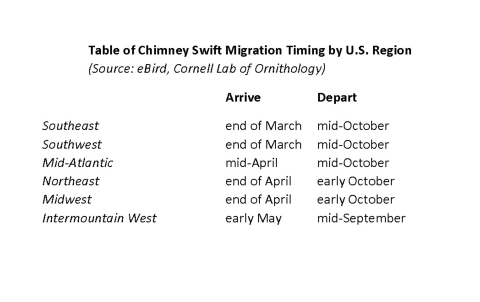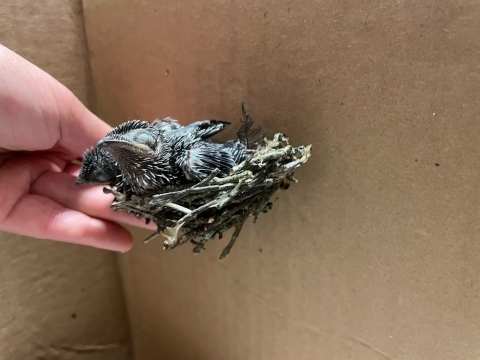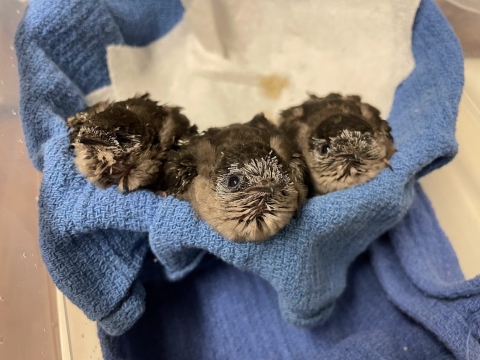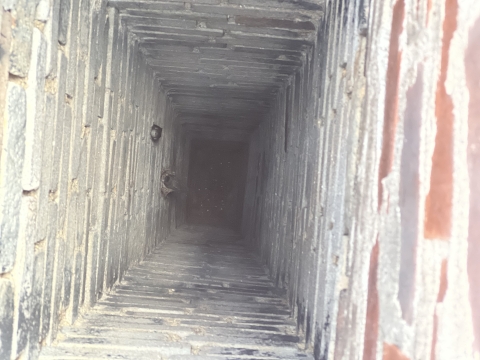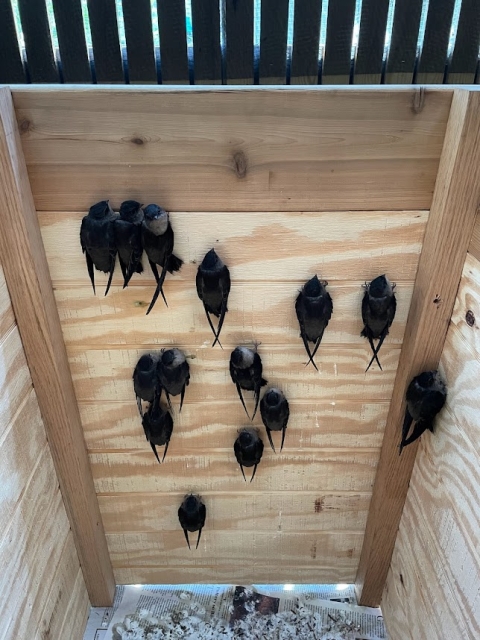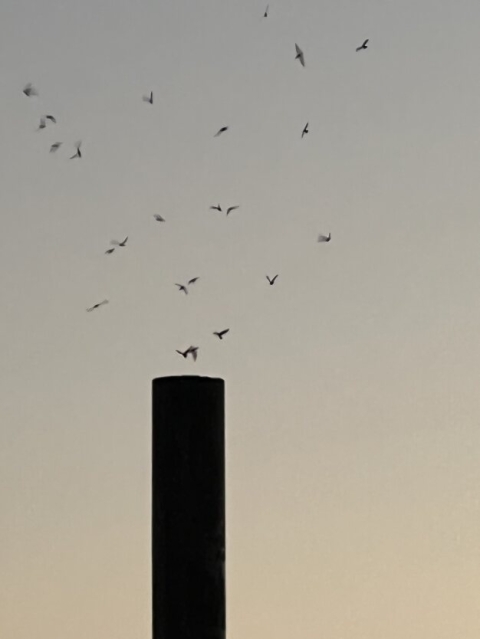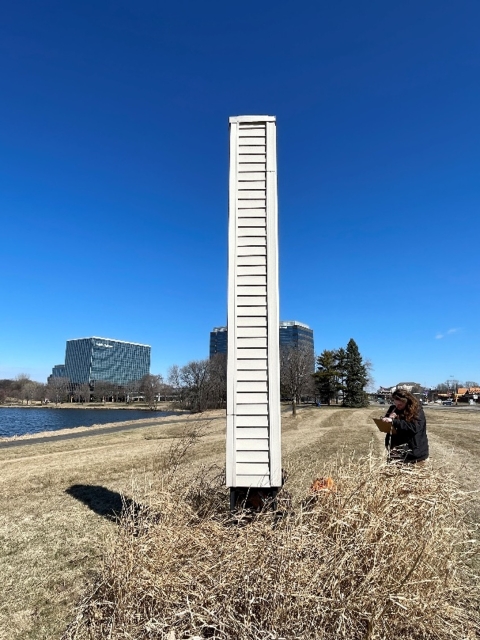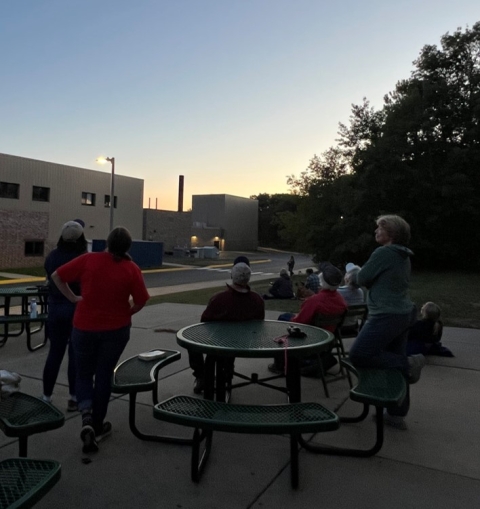Introducing Chimney Swifts (Chaetura pelagica)
The chimney swift is a small, sooty-grey bird that spends its days on the wing capturing flying insects in the air. It has a cigar-shaped body, a short, stubby tail, and long wings that beat so rapidly it can even look like a bat! Its large eyes can focus quickly at high speeds and especially when they suddenly enter the dark spaces of chimneys and other structures that they nest and roost in. Its tail feathers each end in a spine, thus it is part of the group of swifts with the genus name Chaetura, meaning spine-tailed. The spines are used for clinging to and navigating vertical surfaces, as swifts are unable to perch horizontally. The species name, peligica, is due to its wide-ranging nature, spending most of the day in flight, often foraging several miles from its nest or roost site over a variety of different natural and urban habitats. The chimney swift’s exuberant chittering is easy to recognize and helpful for identification. It is more closely related to hummingbirds than swallows!
The chimney swift is a neotropical migratory bird protected by the Migratory Bird Treaty Act (MBTA). Thus, harassing, injuring, or killing swifts, their eggs and their nests is illegal. Chimney swifts arrive in the U.S. in March or April to breed and roost and then depart in August or September for South America’s upper Amazon basin of Peru, Ecuador, Chile, and Brazil, where they like to spend the winter. See the table below for the timing of spring and fall migration for different regions of the U.S.
During fall migration, swifts gather by the hundreds to thousands to spend nights together inside masonry chimneys that are usually larger than nesting chimneys. When re-entering these migration staging roosts at dusk, thousands of chimney swifts can create a swirling vortex that captures the interest and imaginations of crowds of people who gather to view these stunning displays in neighborhoods across the U.S. These events are called Swift Nights Out or Swift Sits. At these events people not only enjoy watching the spectacle of so many birds flying together, but they also count the number of birds entering the roosts to help conserve them.
True to their name, chimney swifts nest individually in masonry chimneys and other human-made structures, such as barns, silos, and vents. They cling vertically to the sides of these structures, which are made of brick, stone, mortar, or other material that has a rough, porous texture. That texture helps them cling more easily. The swift pair builds a small half-saucer nest made of twigs and their own saliva, which they attach to the inner wall of the chimney. Sometimes nest chimneys are also used by helper birds and other non-breeding roosting birds. Swift pairs tend to return to the same nesting chimney every year.
Fun Facts About Chimney Swifts
- Among the fastest flyers in the bird world---60 miles per hour or more
- Can echolocate but not as well as bats
- Dine exclusively on flying insects, eating one-third of their body weight per day
- Despite their small size (21 g), they can fly up to 500 miles per day while hunting insects
- Forage at great heights – above buildings and treetops – 65 to 3,000 feet or more
- Captures more than 1,000 flying insects a day---up to 12,000 when feeding young
- Annually fly more than 6,000 miles (10,000 km) on round trip migrations to South America and back.
- Can fly over 1.2 million miles (2 million km) in a year
- Can live up to 14 years in the wild, but most have a life span of about 4 years
Chimney Swifts Are In Serious Decline
Before European settlement in the U.S., chimney swifts used large hollow trees and tree cavities in old growth forests, but most of this habitat has been lost to development. As urban areas expanded, swifts began using masonry chimneys and similar human-made structures in and around towns and cities. Although chimney swifts initially adapted well to human settlement, its population has been in serious decline over the last several decades.
Chimney swifts are in a group of birds called aerial insectivores, along with swallows, flycatchers, and other species of swift that catch insects while flying in the air. These species are experiencing severe population declines due to loss of their insect prey populations, habitat loss and degradation, collisions with buildings, climate change climate change
Climate change includes both global warming driven by human-induced emissions of greenhouse gases and the resulting large-scale shifts in weather patterns. Though there have been previous periods of climatic change, since the mid-20th century humans have had an unprecedented impact on Earth's climate system and caused change on a global scale.
Learn more about climate change , and severe weather events. Chimneys suitable for swifts have not been built since before the 1960’s and thus, many have deteriorated and require repair. Moreover, many existing swift-occupied chimneys are being capped, renovated, or demolished as part of urban renewal projects. In addition, habitat loss and chemical pesticide use are adversely impacting the swifts’ food supply – airborne insects.
The chimney swift was once a common bird but is now a U.S. Fish and Wildlife Bird of Conservation Concern, a Road to Recovery Tipping Point Species, a State of the Birds Tipping Point Species, and a Species of Greatest Conservation Need in 22 states.
What Kinds Of Chimneys Are Good For Swifts?
- Swifts usually choose brick, stone, or mortar chimneys.
- A chimney must be large enough for swifts to open their wings and fly inside. So, chimneys need to have a horizontal course of 2½ by 2½ bricks or be at least about a foot (28.5 cm) in diameter (circle) or diagonal (rectangle or square). Roost chimneys tend to be larger.
- The chimney should rise at least 6 ½ feet (2 m) above the roofline.
- The top of the chimney must be open and not covered by mesh, wire screening, concrete slab, metal cap, top-knot, etc. or obstructed by vegetation.
- Swifts like to nest and roost near other swifts so even though they do nest individually, they are communal in nature. There is often a network of nesting and roosting chimneys that are in close proximity to one another.
- Chimney swifts also sometimes nest and roost in chimneys that are exceptions to these rules!
Do I have A Chimney That Swifts Could Use?
To figure out if swifts already use your chimney, you first need to examine your chimney for the attributes listed above. If your chimney is potentially good for swifts, then look carefully for nesting and roosting swifts from March to October, depending on your location (see table above). Evidence of swifts may also be found during the off-season when swifts have migrated out of your area and are wintering in South America.
From March to October, depending on your location, you may hear or see one or more breeding swifts or helper birds during the day coming in and going out of the chimney feeding the young. Swifts spend most of the day foraging several miles or more from the chimney gathering insects.
If you have nesting swifts, you may hear the nestlings begging during the day when a parent bird enters the chimney with food. This only occurs during a three-week period in spring/summer.
For a roost chimney, you might see – and hear--large numbers of swifts chittering and entering the chimney at dusk -- sometimes in an amazing vortex of movement! Watch for 20 or more swifts at smaller private chimneys, and hundreds to thousands at larger public or industrial chimneys, such as churches, schools, stores, museums, historic buildings, and industries.
In the winter season, for larger public or industrial chimneys, examine materials on the floor of the shaft (via the cleanout) such as feathers, eggshell fragments, twigs from nests, dried carcasses, and skeletal remains.
For a fireplace chimney, check for debris on the smoke shelf and the floor of the fireplace.
However, lack of evidence during an off-season check is not sufficient to conclude that swifts have not occupied the chimney. Check for swifts over the course of several years as they can switch nests and roosts within an area from year to year. Nesting swifts can be very discrete around their chimney, so be watchful of the airspace above your chimney!
Conserving Chimney Swifts: How to be a Good Swift Chimney Host
If you host swifts in your chimney, consider yourself lucky! You have the rare privilege of watching the life story of a species at risk unfold right on your own premises. They eat huge numbers of flying insects, make minimal mess, do no structural damage to the chimney, and pose no fire or health hazard. The information below describes best practices for being a welcoming chimney swift host.
Best Practices for Being a Chimney Swift Host
- Clean your chimney every year--- but do it outside of swift nesting and roosting season. For most of the U.S., that means you should clean your chimney between September/October to March/April (see table above). Cleaning off the creosote created by fires is extremely important for both fire safety and to ensure that swifts can cling to a clean, porous surface.
- Only do chimney or roof inspections and repairs during the time of year when swifts are not present and ensure that your actions do not limit chimney swift access or use.
- Only use your furnace or fireplace during the time of year when swifts are not present.
- Find chimney sweeps, masons, and inspectors who are knowledgeable about protecting chimney swifts.
- Keep the damper of your fireplace closed after heating season is over to better protect nesting and roosting swifts from falling into the fireplace or accessing the house.
- Do not cap the chimney or install a wire screen to keep out nuisance wildlife.
- If your chimney is capped and you have a chimney suitable for swifts (see above), consider removing the cap in the spring so that swifts can use your chimney.
- To keep nuisance animals out of the chimney, trim back overhanging foliage and securely wrap a 2-foot (60-cm) wide band of metal flashing around the outside of the chimney near the top.
- Do not line your chimney with metal, as it is far too slippery for swifts to cling to.
- Ensure chimneys being considered for sale, renovation, or other modifications are preserved and maintained for swift use, in terms of size, height, accessibility, and internal surface material, and that a separate flue or other chimney structure structure
Something temporarily or permanently constructed, built, or placed; and constructed of natural or manufactured parts including, but not limited to, a building, shed, cabin, porch, bridge, walkway, stair steps, sign, landing, platform, dock, rack, fence, telecommunication device, antennae, fish cleaning table, satellite dish/mount, or well head.
Learn more about structure is built for heating purposes. - If your chimney already has a metal lining, it is important to cap the chimney to prevent birds and other wildlife from getting trapped inside.
If pruning trees, leave some dead branches with fine twigs at the tips for swifts to use as nesting material.
- If you are bothered by the food-begging calls of young swifts during the three weeks before they leave the chimney, stuff foam rubber (not fiberglass insulation) above the damper in your fireplace; be sure to remove it later.
- If nestling chimney swifts fall from your chimney, please contact a licensed migratory bird rehabilitator. They can help guide you on how to re-nest the swifts back into the chimney, or tell if you if the swifts need medical attention.
- Avoid having excessively noisy activities in the fireplace room when an active nest is in the chimney; otherwise insert insulation as above.
- If your chimney is host to a swift roost, maintain an unobstructed area around the chimney so that large numbers of swifts have easy access to the opening.
- Build small networks of chimney swift nesting and roosting towers with educational kiosks, using an appropriate design based on latitude, and assess their use through regular monitoring for swifts and tower attributes.
- If heavy rainfall might cause water to run down the inside of the chimney and dislodge a swift nest, construct a small roof supported by four, thin, 12-inch (30-cm) tall legs; secure in place above the chimney opening.
- If you are no longer using your chimney and it is in poor shape, don’t demolish the entire chimney as upper parts usually deteriorate first. Instead, consider removing the deteriorated upper part and constructing a new rim around the top, while leaving the shaft open. The chimney should still be at least 6.5 feet (2 meters) above the roofline. All construction should be done outside of swift season as described, when there are no swifts present.
- If chimney demolition is unavoidable due to safety concerns, mitigate the structure’s loss by undertaking one of the following actions, listed in priority order:
- Construct another swift chimney on the future building.
- Construct another swift chimney on a nearby building that either has a chimney that supports swifts and/or is also near an existing swift chimney.
- Construct a separate swift tower nearby (within 100 feet of the current structure).
- Reopen chimneys that are blocked and not accessible to chimney swifts, primarily those that are suitable for swifts, have been previously occupied by swifts, or are near swift chimneys.
All of the above constructions of new swift structures should be started after the swifts have left in the late summer/fall and be completed before they return in the spring.
Enjoy Chimney Swifts and Help Them Survive!
If you host chimney swifts, you can enjoy watching their amazing aerial acrobatics as they swoop about capturing insects. They make headlong dives, then drop bottom end first, into the chimney! You can also become a steward and educate others by inviting friends and neighbors to watch your swifts.
If you are not a chimney swift host, you can still enjoy them and learn more about them. Below are some actions you can take to help them:
- Participate in a Swift Night Out near you to enjoy and help count swifts returning to their roost sites at dusk. Our partners in Wisconsin have lots of great resources to help you get started.
- If you observe chimney swifts, record your observations on eBird and contact a local organization that sponsors Swift Night Out or other swift monitoring events or programs (see below).
Participate in a chimney swift monitoring effort to identify, monitor, and protect swift chimneys. Visit websites for programs in CT, MI, MN, TX, WI and other non-governmental organization sites for more state-based information.
A group of people enjoy watching chimney swifts come out of a decommissioned smokestack in Minnesota at a Swift Night Out event.
Don't Have A Chimney, But Still Want To Help Chimney Swifts?
If you don't have a chimney, but you still want to help chimney swifts, there are some easy and great steps you can take! It's really important to make sure that swifts and other aerial insectivores have plenty of food – flying insects -- to eat and feed their young.
Insects are produced in natural habitats, such as wetlands, streams, meadows, and woodlands, where they fly or waft upward and are eaten by swifts and other birds and bats. In addition, many insects go through a caterpillar stage when they forage on plant parts such leaves, twigs, buds, or stems. Pesticide use and ongoing loss of natural habitat is reducing the chimney swift’s insect food supply, which is likely contributing to declines in chimney swifts and other aerial insectivores.
- Plant native species of trees, shrubs, wildflowers, and grasses: native plants provide food for more pollinators and other beneficial insects than non-native plant species.
- Consider waiting to mow your lawn in early spring (no mow May!) to allow flowers to bloom and help early season pollinators.
- Leave your leaves alone as pollinators and other beneficial insects rely on the habitat fallen leaves provide, especially over the winter months. Dead leaves also decompose creating compost that can improve soil structure and fertility.
- Convert your lawn or part of your lawn (which has limited value for insect production) to a native plant garden. Aiming for 70% native plants is a good rule of thumb to benefit pollinators and other beneficial insects.
- If you own a rural property, encourage fencerows, un-mowed ditches, and natural areas as insect nurseries.
- If you live in an apartment, set out a balcony pot of native plants to help feed insects that help feed swifts.
- Discontinue using pesticides and herbicides, which kill insects and the plants that many insects and other wildlife rely on for food.
- Protect and restore habitats such as woodlands, wetlands, and native meadows where insects live and breed.
- Make your home or other building safer for chimney swifts and other birds by taking steps to reduce or eliminate building collisions and keeping artificial lights off between dawn and dusk during fall and spring migration seasons.
- Take pride in the important contribution you are making to chimney swift conservation!
- For more information about Chimney Swifts and how to conserve them, visit http://www.chimneyswifts.org/


